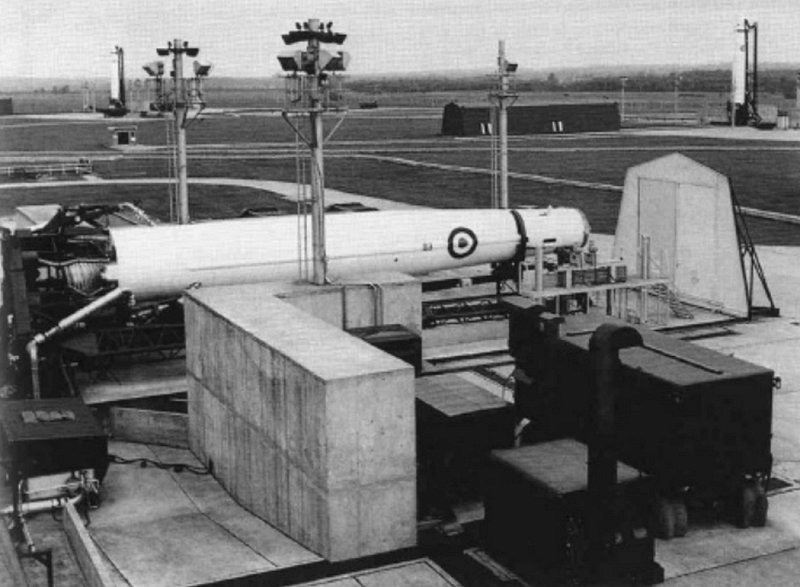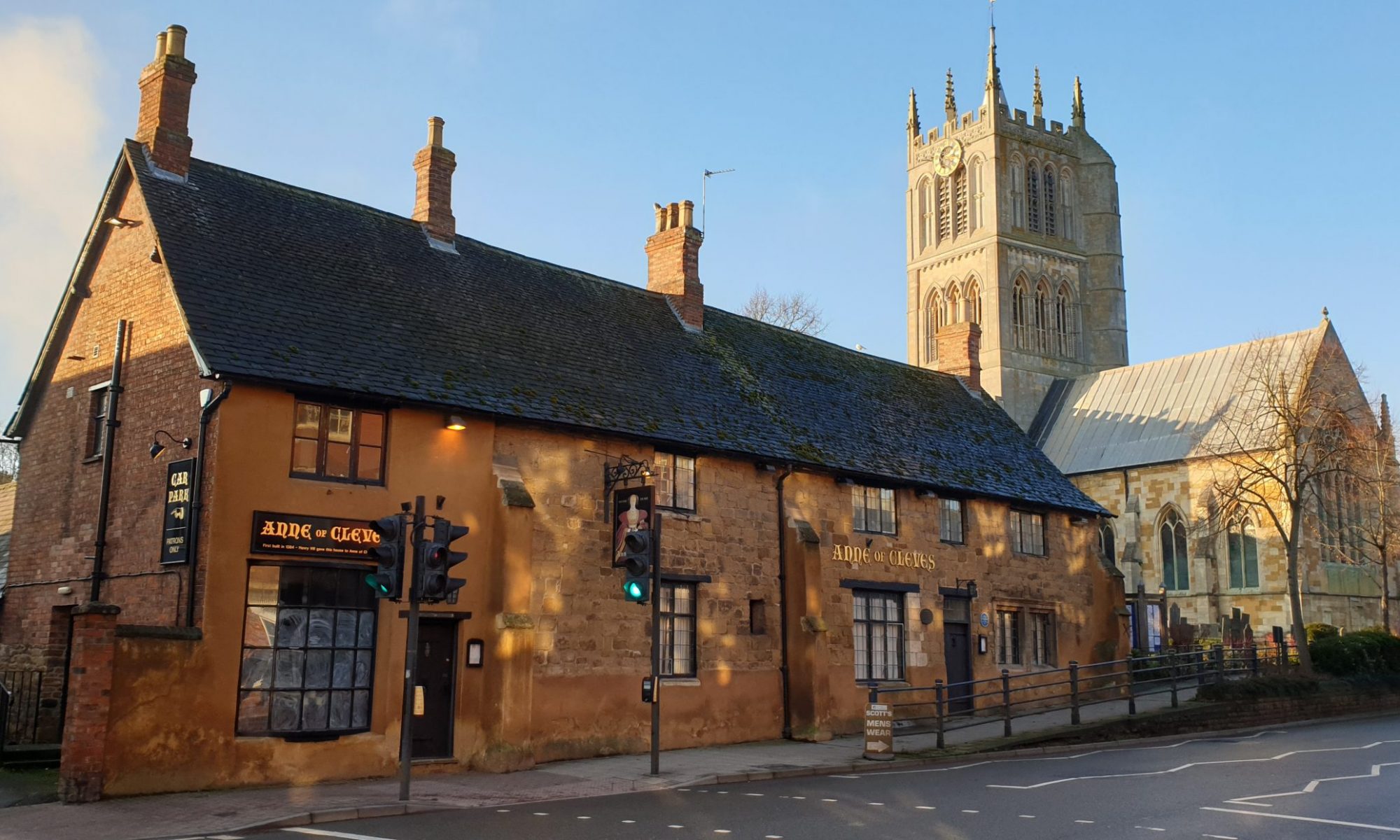In blog No 15, I looked at the history of RAF Melton Mowbray during World War Two and its important role transporting aircraft around the world to support both the Royal Air Force and the Royal Navy Fleet Air Arm in whatever theatre of war they were engaged in.
In this blog, I continue the story of the former RAF station and skip ahead about 13 years after the end of World War 2 to the late 1950s when the country and the RAF was at the forefront of another global war – The Cold War and RAF Melton Mowbray became part of the countries vital nuclear defence network protecting our country.
Just over a year after the end of the Second World War, in November 1946, the Air Ministry issued an Operational Requirement, known as OR230, for an advanced jet bomber capable of carrying a 10,000-pound bomb to a target 2,000 nautical miles from a base anywhere in the world. The bomber needed to fly at an altitude of between 35,000 and 50,000 feet with a cruising speed of 500 knots.
A request for designs went to most of the United Kingdom’s major aircraft manufacturing companies including Handley Page, Armstrong Whitworth, Avro, Bristol, Short Brothers and English Electric. At the same time, another aircraft company, Vickers-Armstrong had produced a swept wing design, but this had been rejected as it did not meet the required specifications.
By the time the RAF’s strength reached its post war peak in 1956, the decision had been made by the Air Ministry and three companies that had made famous bombers during World War Two had been selected to produce the new jet bombers. They were Avro, producer of the infamous Lancaster bomber, Handley Page, producer of the Halifax bomber and Vickers, producer of the Wellington bomber. The three new aircraft that finally entered service were known as the Vulcan, the Victor and the Valiant respectively, becoming commonly known as the V Force. These aircraft were to be used as the country’s Nuclear Deterrent.
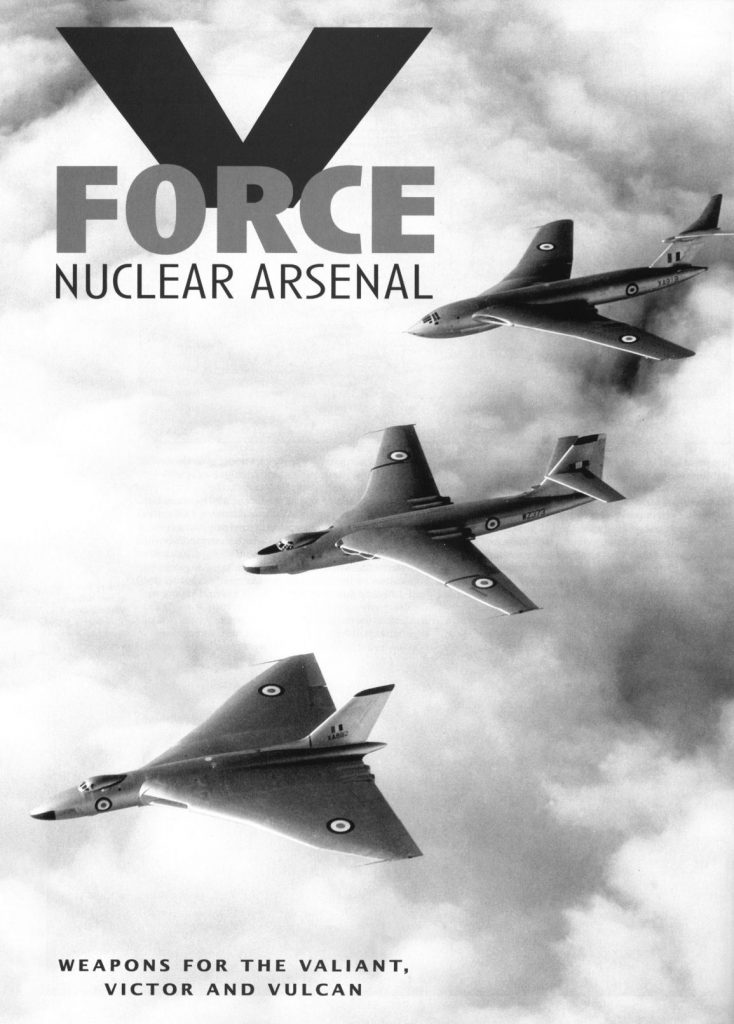
October 1956 saw the outbreak of the Suez War, and RAF aircraft were heavily involved in the crisis. The diplomatic debacle of the Suez saw a dramatic rethink in defence policy. The first manifestation of the new defence thinking was the infamous 1957 White Paper, in which Duncan Sandys, the Minister of Defence, forecast the end of manned aircraft and their replacement by guided missiles.
It was during he Suez crisis that the British Government began discussions with the American Government the potential for basing a nuclear missile force in the United Kingdom.
The US gained much of its rocket expertise from German scientists that had previously been involved in the V1 and V2 vengeance weapons projects run by Germany during World War Two. Apparently, there were over 500 rocket scientists that had voluntarily gone to the USA after the war to be employed in the aviation industry.
As a result of their experience, the USA already had two intermediate range missiles under development, one project run by the US Army named Jupiter (the bringer of Jollity) and the other by the US Air Force (USAF) named Thor (the God of Thunder).
The major problem the Americans were experiencing with both of these projects was the range of the missiles, which was limited to somewhere in the region of 1500 miles. This was nowhere near enough to strike at targets deep within the Soviet Union with missiles launched from within the US homeland. The only way the US could make practical use of the missiles was to deploy them in friendly countries nearer to the Soviet Union.
In 1957 an initial proposal from the USA was put to Britain to deploy Thor Intermediate Range Ballistic Missiles (IRBM) in the UK. The plan was to deploy four Squadrons of nuclear tipped missiles with each squadron comprising fifteen missiles at a single base. Two squadrons were to be manned by USAF personnel and the other two by RAF personnel.
The Thor missile was an Intermediate Range Ballistic Missile with a range of 1,750 miles, armed with a two megaton nuclear warhead, it stood 65ft tall with a base diameter of 8 ft and could travel at a speed 12 times faster than sound.
The proposal was regarded favourably by Britain’s new Prime Minister, Harold Macmillan. Negotiations took place following concerns raised by the British Government and the original concept of having two USAF squadrons and two RAF Squadrons had now changed to all four squadrons being run by the RAF with USAF support.
The negotiations also reconsidered the bases where the missiles would be located. The original plan included basing a squadron of missiles at RAF Brize Norton near Oxford, but this was rejected as the authorities could not contemplate the prospect of a Thor breaking up after launch and its war head and 100,000lbs of fuel falling on the population and historic spires of Oxford.
The advantage of basing Thor in the UK was that there were hundreds of airfields across Eastern England that had been built on land commandeered during WW2. The authorities clearly didn’t have the same concerns for the rural towns and cities across Eastern England and eventually for sites were selected to hose the Wing HQs and each base had four satellite stations around them.
The sites chosen for the HQ’s were RAF Feltwell, RAF Hemswell, RAF Driffield and RAF North Luffenham. Each HQ site had to be adjacent to an active airfield that could be used as the designated airhead so that the missiles and ground support equipment could be flown in as close as possible. The airhead sites chosen were RAF Lakenheath for Feltwell, RAF Scampton for Hemswell, RAF Leconfield for Driffield and RAF North Luffenham.
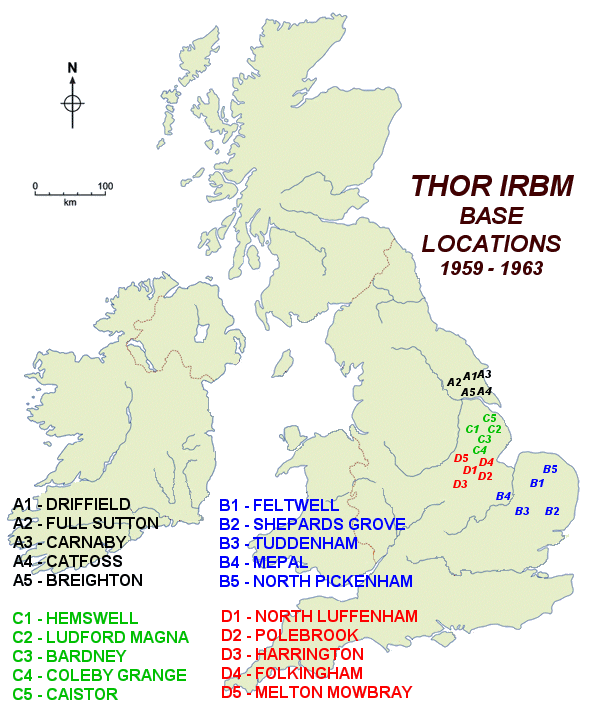
Final agreement on the deployment of Thor in Britain was reached at the Bermuda Conference in March 1957, when Macmillan and Eisenhower met to discuss key issues.
On 1 April, Macmillan reported to Parliament that: “The rockets will be the property of Her Majesty’s Government, manned by British troops who will receive their prior training from American experts. The rockets cannot be fired by any except the British personnel, but the warhead will be in the control of the United States – which is the law of the United States- and to that extent the Americans have negative control; but it is absolutely untrue to say that the President and not the British Government will decide when these missiles will be launched and at whom. So long as we rely upon the American warheads, and only so long, that will remain a matter for the two Governments”.
The emphasis was still on the Nuclear Deterrent, and with the White Papers forecast of missiles replacing the aircraft, 1958 saw the delivery of the American Thor IRBM to the RAF. The missiles were flown into RAF Mildenhall in Suffolk in USAF Globemaster transport aircraft and then transported by road to the launch sites.
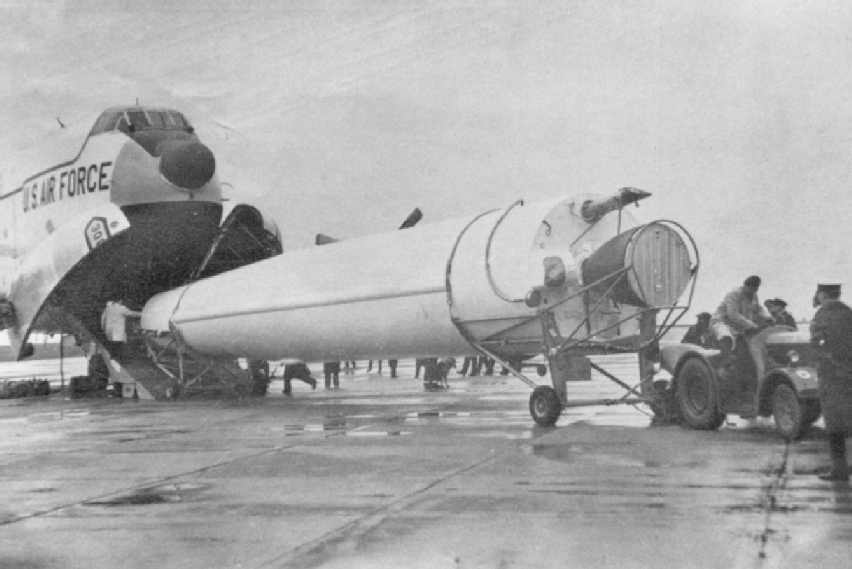
Project Emily was then born and twenty sites were chosen to house the new missiles. In 1958 No.144(SM) Sqn North Luffenham reformed with No 254(SM) Sqn being reformed at Melton Mowbray on 1st December 1959. The other satellite sites being No 130(SM) Sqn Polebrook Northamptonshire, No 223(SM) Sqn Folkingham Lincolnshire and No 218(SM) Sqn Harrington Northamptonshire. (SM stands for Strategic Missile). Each of the five stations were equipped with a Thor missile complex housing 3 missiles and came under the control of Bomber Command.
The HQ was at a permanent station, in this case North Luffenham, as well as being the HQ it was also responsible for the care and maintenance of the satellite sites and their missiles. The dispersed sites were erected in the middle of disused wartime airfields and the contract for the construction work was given to Monks Construction Company.
No 254 Squadron was reformed as a unit of No 3 Group Bomber Command on 1st December 1959 at RAF North Lufenham and its task was to operate the Thor missile from the disused former RAF airfield at Melton Mowbray. Following reformation, the Squadron became known as No 254 (SM) Squadron .

The crest for No 254(SM) Sqn shows a Raven, with its wings endorsed and inverted. The motto “Fljuga vakta ok ljosto” when translated means “To fly, to watch and to strike” refers back to when the squadron was initially formed in August 1918 at a Coastal Reconnaissance station and was employed on anti-submarine patrols.
No 151(S.A.M.) Wing, Fighter Command was formed equipped with Bloodhound missiles to provide anti-aircraft defence for the Thor sites. No 62 Sqn was reformed on 1st Feb 1960 at RAF Woolfox Lodge in Rutland, No 257 Sqn was reformed on 1st July 1960 at RAF Warboys, Hunts and the Wing HQ was based at RAF North Luffenham. These missiles which were the first to become operational in the Western world using continuous wave radar guidance systems, were intended to operate in conjunction with the Hunter and Javelin aircraft already operated by Fighter Command in the Air Defence role.
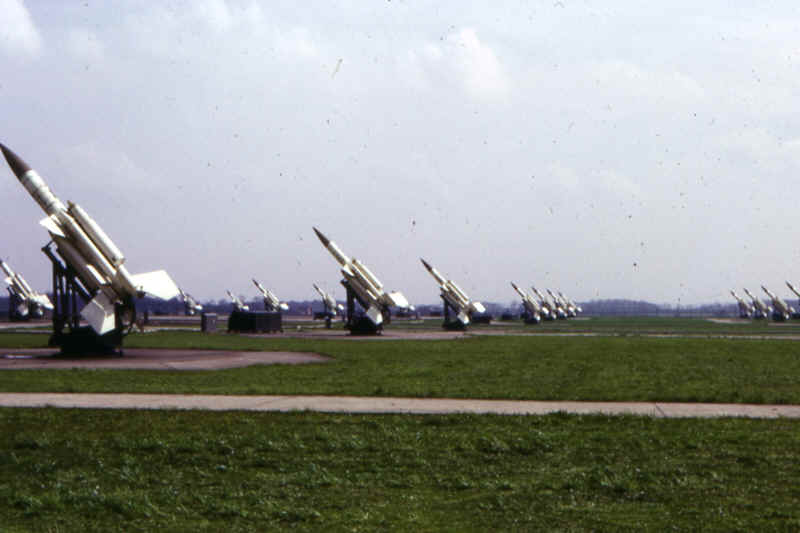
The squadron consisted of three Thor missiles, each on a launch emplacement and the Squadron establishment as follows: Sqn Ldr D F Liddle, Squadron Commander, and 5 Flt Lts, G A Boston, G F Craig, K G Shaw, J Waiting and W P Wallington.

Each of the Flt Lts commanded a launch crew consisting of one Flight Sergeant or Warrant Officer Master Aircrew as the Launch Monitor Console Operator, three technicians as Missile Maintenance Technicians, one Power Production Operator, four Firemen, four Cooks, eighteen Policemen and one Clerk, all of which were RAF personnel.
The RAF launch crews had to undertake training courses to maintain this new weapon system. Personnel who joined the Thor force had to undertake approximately 20 separate courses which were held in different parts of America and lasted anywhere between two and twelve weeks. The main locations were Tucsan in Arizona and Vandenberg in California.
Following the Sqn reformation, the first task for the RAF personnel was to undertake refresher training from 18th January 1960 to 8th March 1960 at RAF North Luffenham and RAF Feltwell. During this period, the contractors continued to install the equipment for the launch pads and where possible, Sqn personnel assisted when they weren’t on training.
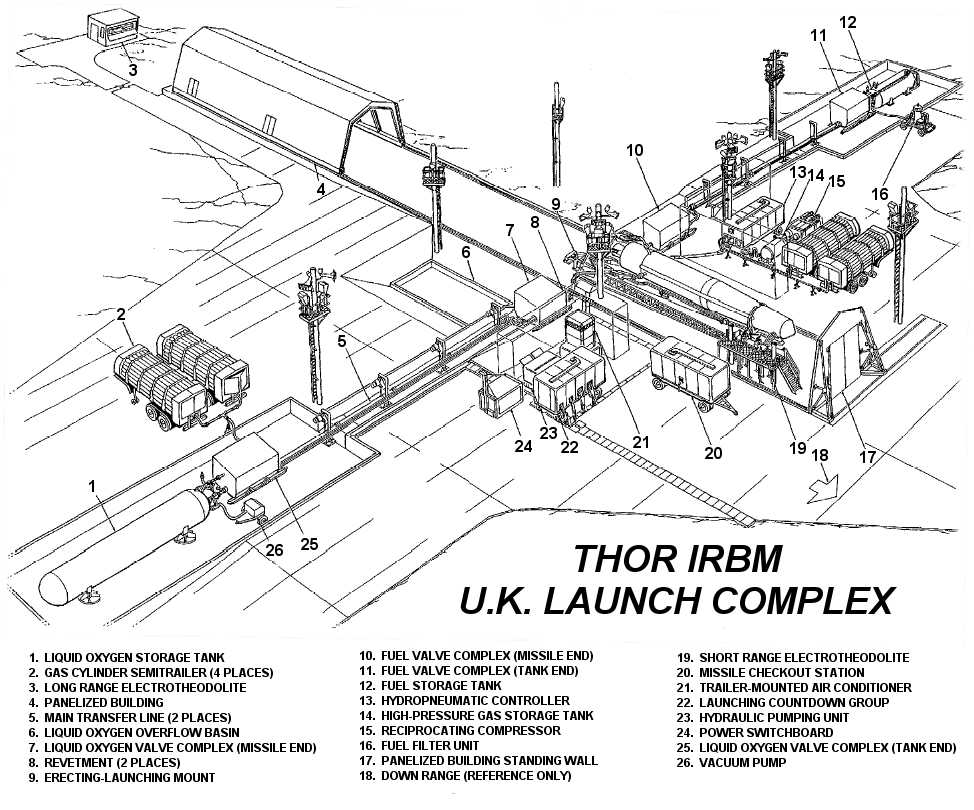
The Thor sites were subject to a number of “Ban the Bomb” demonstrations by groups from the Direct Action Committee Against Nuclear War. Melton was subjected to several such protests with one taking place on the 18th/19th June 1959 and another on the 27th February 1960, when a protest march was undertaken from Leicester to RAF Melton Mowbray. It is reported that the protest was ignored by the squadron personnel on advice from the civilian police and following a few speeches made by the protesters, it terminated peacefully.
The Newcastle Evening Chronicle published the following article on the Friday 19th June 1959 edition:
“Rocket site protest party stays
Miss Pat Arrowsmith and her companions of the Direct Action Committee Against Nuclear War were today still picketing the main gate of the rocket site near Melton Mowbray (Leicestershire) where last night they demonstrated.
After the demonstrators had been warned they would be trespassing If they attempted to break In, Miss Arrowsmith the field organiser led her followers off along the road. Half a mile away they found a second unmarked gate.
Some of the demonstrators climbed over and with banners held aloft began marching towards the site. Five others stayed at the gate handing out leaflets. Police picked up the unresisting demonstrators who had sat down and carried them to the perimeter.
The demonstrators then pitched tents on the roadside verge. Today four members of the committee were still there. Miss Arrowsmith proposes to stay on until the workers knocked off at the end of the day.
The Torbay Express and South Devon Echo also published an article on the same day:
“Pat stays `on duty’
Miss Pat Arrowsmith, daughter of Rev. and Mrs. G. K Arrowsmith, of Torquay, and her companions of the Direct Action Committee Against Nuclear War, who last night demonstrated at a rocket Site near Melton Mowbray (Leics.) were to-day still picketing the main gate.
The demonstration started last might with pickets and police talking over cups of tea.
When the demonstrators started marching towards the site, Air Ministry and civil police moved round to block off their route and warned them to leave. Miss Arrowsmith and her followers promptly sat down.
Police picked up the unresisting demonstrators, and, with Miss Arrowsmith laughingly apologising for her weight, carried them to the perimeter. They then went back for the tents which the invaders had been carrying handed them over.
Local farmer Bill Johnston recalls one incident at Melton when he was in his tractor delivering a trailer full of manure to the airfield and when he arrived at the Crown Hill gate at the Great Dalby end of the airfield and protester Pat Arrowsmith was lying down in the road to prevent access to the site. The Police had to be called to remove her and allow him access to the site.
Bill used to help cut the grass on the airfield and remembers one day when he was a passenger on a tractor when they stopped off for a T break at the NAAFI Wagon. As they were sat enjoying their brew, Bill recalls how he was given a bar of chocolate from a black American serviceman.
During March 1960, the squadron took partial control of the equipment from the contractors and 24 hour watch keeping began on the 8th March 1960. The installation programme was completed by the 8th April and the RAF squadron personnel took full control. The squadron was represented by Flt Lt Wellington, Sgt Gibson, Cpl Techs Barron and Chatfield at the official handing over ceremonial parade at RAF North Luffenham on the 5th May 1960.
In June 1960, Flt Lt Waiting organised two large fire practices on the site involving both RAF personnel based at the site along with the civilian fire brigades from Melton Mowbray and Oakham so they could be familiarised with the site fire hazards.
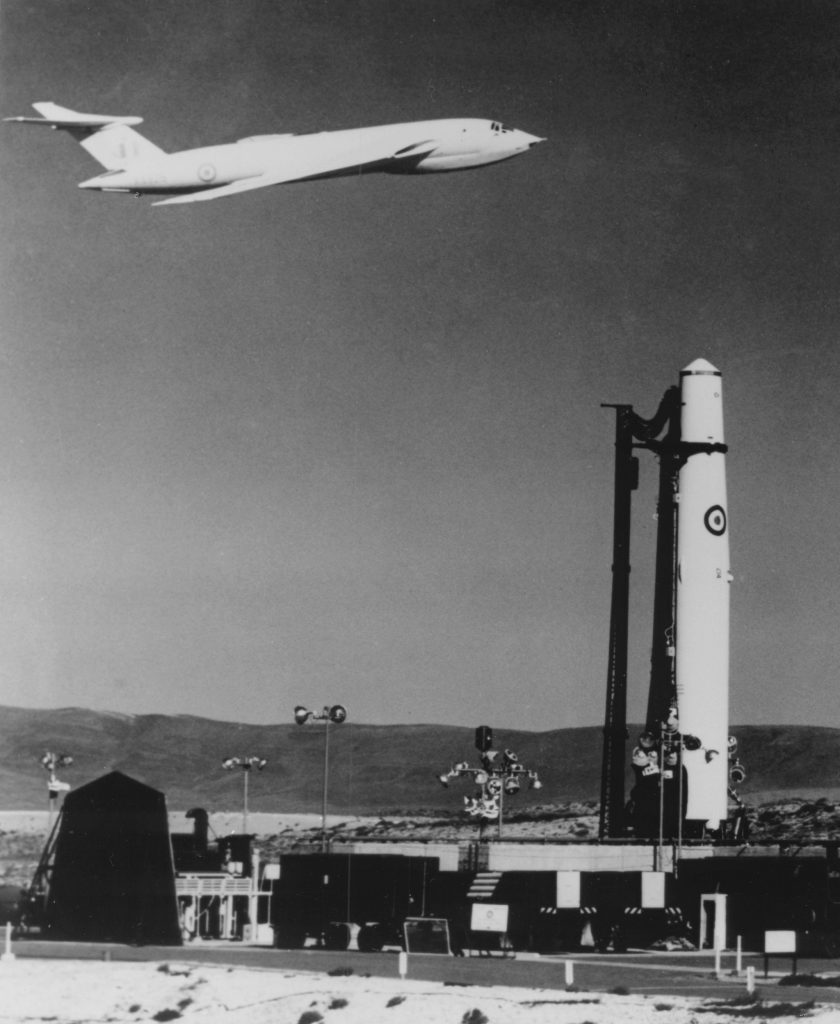
The operational capability of the system was proven by carrying out a number of “Combat Training Launches”. The procedure for this was to remove an ageing missile from its launch pad, remove the nuclear warhead and fly the missile to America. A new missile would be positioned on the launch pad so that a full complement was always kept. The ageing missile would be set up on a launch pad at Vandenberg Air Force Base in California and fired down the Pacific Missile Range. Three of these launches were carried out by crews from the Luffenham complex. The first ‘North Luffenham’ Combat Training Launch was carried out in October 1960 by Flt Lt E G Shaw and his crew from 254(SM) Sqn RAF Melton Mowbray.

Any launch order, simulated or otherwise, had to be authenticated by the RAF and USAF officers at Bomber Command HQ, High Wycombe, where Seventh Air Division’s HQ was also located, using a special and highly secret code. Operation of the Thor required a lengthy countdown procedure, so in time of war the system required considerable warning of impending enemy activity; on average, the sequence required something like 15 minutes from receipt of the positive launch order. At that point the RAF launch Control Officer turned a phase sequence key to initiate a fully automatic sequence of events:-
Phase 1: All equipment and targeting data checked. Countdown sequence initiated
Phase 2: Shelter retracted and missile erected. Targeting data entered.
Phase 3: Missile loaded with fuel. Target data and missile valves rechecked
Phase 4: Missile functions transferred to internal power source and missile topped up with liquid oxygen (LOX) if required.
Phase 5: Authentication launch codes received. Keys turned and engines started.
Another ‘North Luffenham’ Combat Training Launch was carried out in August 1961 and was rather unique. Back home in the UK, a campaign was underway by ‘Rutlanders’ to try and prevent their tiny county being overtaken by its larger neighbour Leicestershire. The launch crews were aware of this and slapped a “Hands off Rutland” sticker on the nose of the missile and as they watched the launch on TV, they saw the Rutland campaign go into orbit. The third launch was on 19 June 1962. All three launches were a success and proved the operational aspects of both the missile and the RAF crews.
On the 23rd November 1960, there was a security alert at the Melton Thor site when a light aircraft landed on the disused runway. The aircraft as rapidly surrounded by the duty police patrol and security alert measures were set in motion by the duty officer Flt Lt Wallington. The alert ceased when it transpired that the occupants of the light aircraft were two Frenchmen who were unsure of their position had landed at what they believed to be RAF Cottesmore.
At 05:30Hrs on the 4th December 1961, No 245(SM) Sqn received an issue of ‘Alert Condition 3’ from Bomber Command Operations Centre as part of the Bomber Command Exercise “Redouble”. When the alert was received, the Squadron was engaged in carrying out periodic maintenance inspections on the launch pads. One pad had power supply issues and a second was at Standby and brought to Exercise Ready state in seven minutes with a second following at 11:07Hrs and the third at 22:05Hrs. During the exercise, the Squadron carried out 5 countdowns and the exercise was terminated at 12:06Hrs on the 5th December.
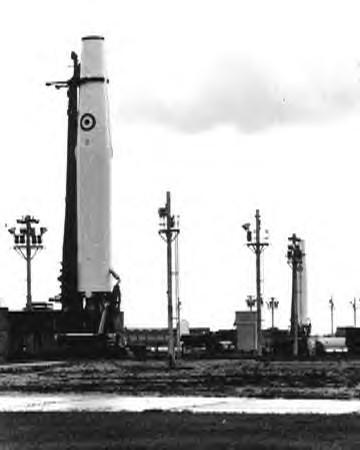
Exercise “Redouble” was a Bomber Command twice yearly exercise testing the Thor force integration within the Bomber Command alert and readiness procedures. The exercise required all launch emplacements to be placed in Exercise Ready condition, meaning off duty crews had to be called back from leave, stand-down etc as the Launch Crews were doubled up and working 12 hour shifts.
Another method of testing the Thor force and its crews was the annual Exercise Mayshot which was the IRBM component of the Exercise Mayflight series. These exercises were designed to test the Bomber Command alert and readiness procedures, similar to that undertaken in Exercise Redouble. As the Thor force was already at constant alert at T-15. the only additional thing that could be tested was the time taken to augment the launch crews. However, Mayshot was a planned exercise with the Sqns having prior knowledge of when it would be executed and as such the crews did not see this exercise as a realistic test of their procedures.
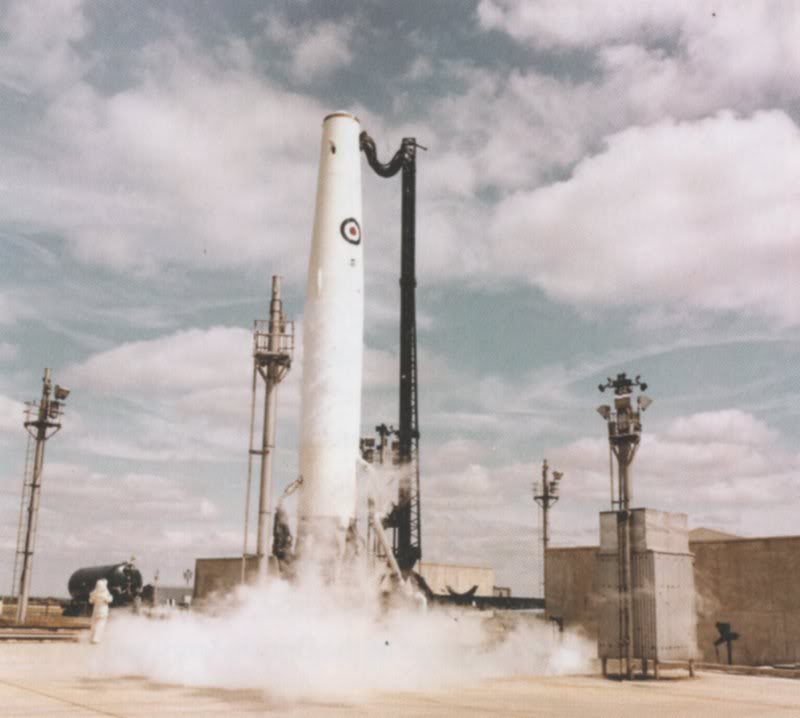
Meltonian, Dave Page joined the RAF in June 1959 as a National Service Policeman. After doing his basic training at RAF Bridgenorth in Shropshire and trade training at RAF Netheravon, Wiltshire he passed out as a Cpl Policeman and was posted to RAF North Luffenham. Dave was pleased with his posting as he was born and bred in Melton.
While stationed at North Luffenham, Dave was responsible for the security of the Thor sites, including the satellite stations. When on duty at Melton, he lived at home with his parents. Dave recalls that the Thor sites were surrounded by two chain link fences with barbed wire tops. These fences ran parallel around the site with a 10m ‘sterile area’ between the two high coils of barbed wire were set up against the outer fence to prevent anyone climbing the fence.
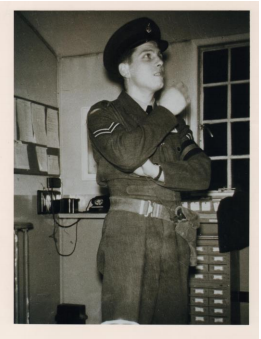
While on duty he was armed with a .38 calibre Smith and Wesson revolver with six rounds. As well as guard room duties, he was duties involved mobile patrols of the perimeter fence, both on foot and in a Land Rover.
While on duty he was armed with a .38 calibre Smith and Wesson revolver with six rounds. As well as guard room duties, he was duties involved mobile patrols of the perimeter fence, both on foot and in a Land Rover.
One of the tasks for the RAF Police protecting the Thor sites was carrying out security checks on other sites where the police would pretend to be intruders and try and gain access to the sites. In August 1962, No 254 (SM) Sqn was subjected to one such attack and three potential ‘intruders’ were captured within the sterile area. Some of the intruder attacks were more successful than other. A few weeks earlier, B Crew were on duty on the 31st July when the site was attacked by the so called intruders. They admitted that they had managed to gain entry to the site and escape detection for almost half an hour but confirmed that they were unable to penetrate onto any of the launch pads or vital points due to the general busy activity by the site personnel.
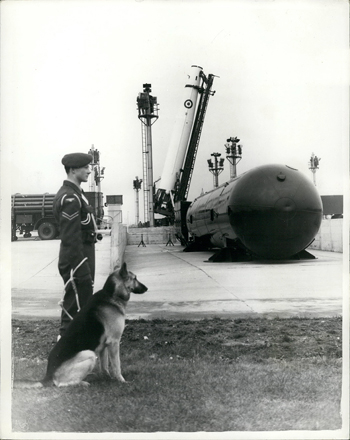
The Cuba crisis in 1962 saw both the V-Force and the Thor Force at operational readiness. Across East Anglia, American pilots were strapped in their nuclear-armed aircraft at ‘cockpit readiness. RAF V-bombers were loaded with thermonuclear weapons and held on heightened Quick Reaction Alert at RAF Bases across East Anglia and Lincolnshire.
In addition to the V-force being put on readiness, the 60 Thor launch pads across Eastern England, had their launch crews doubled in strength and the missiles themselves were prepared for firing. On the 27th October 1962, No 254(SM) Sqn was called to Alert Condition ‘ Phase’ 3 with all of Meltons three missiles fully loaded with fuel, their target data and missile valves were rechecked and kept on hold at the end of Phase 3 with the hangars rolled back. It would have taken only a further two or three minutes to complete Phases 4 and 5. With the easing of political tensions, Bomber Command released the missile readiness state to Alert Condition 4 on the 5th November.
A Group Captain in charge of one of the Thor HQ sites recalled some 30 years later “Perhaps the worst thing was to realise that the station and dispersed sites would be hit and destroyed shortly after we had fired our own missiles, or before, if the Russians chose to make a pre-emptive strike. Although I chose not to think too much about it, while the crises was on, it was a great relief when the Air Officer Commanding Group rang to say the heat was off.”
Meltonian Ivan Farmer recalls his days on Thor missiles, although he was based at RAF Feltwell and not Melton: “The Cuban missile crises did change the atmosphere at RAF Feltwell and the other Thor bases. It was the same for everyone at the V-bomber bases too. You took it in your stride but there was a feeling that we may not be long long for this world. WE tried to keep up with it through the radio and the newspapers. We were put on 12 hour shifts and they doubled the number of safety officers to certify the launch codes. There was one lengthy ‘operational hold’ during the confrontation. It was a very tense period. In the local village, the local landlord complained that his pub was empty as no one came in during the crisis.”
Only the most rudimentary plans existed to protect the population and these relied on days of prior notice if they were going to be implemented effectively. Many years after the crises ended, it became clear that the Home Office had done nothing to activate the Civil Defence plans. I wonder how many of the local residents of Melton Mowbray, and other villages surrounding the missile base realised just how much danger they were in?
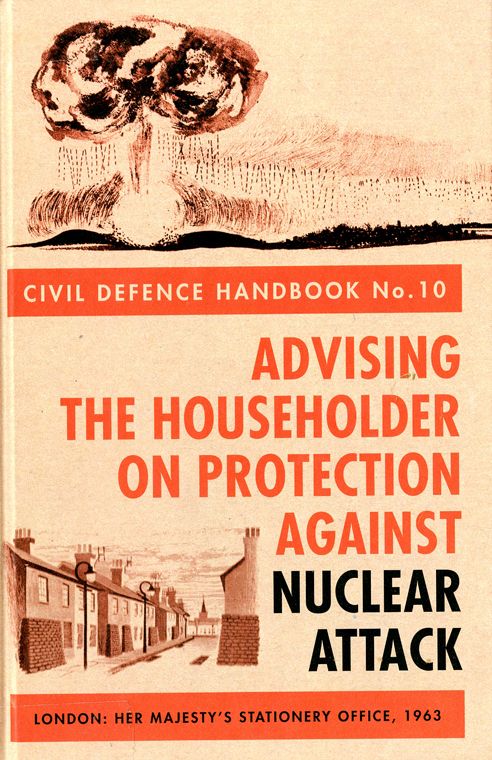
On the 25th July 1963 a party of 48 Air Training Corps cadets who were on camp at RAF Cottesmore visited the site. During their 2 hour visit, they conducted tours of the various areas of the Weapons System with he cadets watching a countdown demonstration on emplacement 57.
The Thor’s reign as the countries nuclear deterrent was a short one, and the missiles ceased to be operational in August 1963 which led to the closure of Melton. The Luffenham complex was the last to close when on the 15th August the site ceased to be operational and No 254 (SM) Sqn disbanded on the 23rd.
An order of the day to Thor squadrons and stations from Air Marshall Sir Kenneth Cross, AOC-in-C, Bomber Command said: “You have maintained a higher rate of readiness in peacetime than has ever been achieved before in the history of the armed forces of the Crown.” Mr. Hugh Fraser, Secretary of State for Air, also sent a message of appreciation to Bomber Command.
When the airfield was finally vacated by the RAF in 1964, most of the facilities including the hangars were dismantled, but the Control Tower survived although derelict until about 1970 when it was demolished.
Following the retirement from service of the missiles, the majority were returned to the US to be used in the space exploration program, either as single stage boosters or in combination with various upper stages, mainly in association with the Telstar, Pioneer and Discoverer programmes. However, you can still see two examples of the Thor here in the UK with one being on display in the Cold War display at the RAF Museum Cosford and the other can be found in the Space Centre at Leicester
The Thor missile site at the former RAF North Luffenham has been given a Grade II* listing as a reminder of the “knife-edge moment in history”. The site is one of two of the most intact examples of Thor missile bases in England, the other is at the former RAF Harrington in Northamptonshire – now mainly farmland -– which is Grade II listed. The concrete launch pads and blast walls still remain at the former Rutland RAF base, along with mounting bolts for the platforms that would raise the missiles into a vertical firing position.
For more information visit the Historic England site to see their listing entries for the former missile sites at North Luffenham and Harrington
Tony Calladine, English Heritage’s designation team leader for the east of England, said: “Melton Mowbray wasn’t put on the list because it didn’t survive well enough. Only those which have survived most intact were selected.
“Oh Happy Days” – Melton resident Mike Mayfield has clear recollections of the missiles:
“I can clearly recall visiting my Grandma’s farm at the top of Cuckoo Hill, between Stapleford Lane and the road to Whissendine, and on many a summer’s evening whilst hay making or harvesting, looking across towards Melton Airfield from the high vantage point, and seeing all 3 missiles in an elevated position and floodlit. Quite a sight as darkness fell!
A more direct and intimate reminder happened in the summer of either 1964 or 65. I was a student at Leicester College studying Quantity Surveying, and being unable to get temporary work in the Building Industry in Melton during the summer holidays, I found employment with Mr. George Houghton of Leesthorpe, a well-known gentleman farmer and Leicestershire County Councillor.
George had the grass mowing rights at RAF North Luffenham, and for 6-8 weeks we would leave Leesthorpe every morning with about 6 or 8 Fordson Major tractors pulling either 1 or 2 four wheeled trailers- quite a sight driving over the level crossing and through the centre of Oakham with a ‘long train of trailers behind’.
Each morning we checked in at the Guardroom at the main gates, and whoever was first there would purchase the tickets for lunch in the Airmen’s Mess, at a cost of 3 shillings and 6 pence in old money!!
After a morning of mowing, turning and baling hay, followed by a huge lunch in the said Mess, half of the afternoon was spent lounging around on a stack of bales reading the Daily Mirror or similar newspaper.
To get to the point, we in fact worked round all the missile bases, dodging in and around the blast walls etc and avoiding the open duct ways. Needless to say the missiles had long gone, but there was still evidence of their former presence.
We also worked in the Airfield’s ammunition compound, where we had to open up, enter and lock ourselves in for the day.
At the end of each working day we would load up the trailers and wend our way back to Leesthorpe, needless to say 1 loaded trailer was enough to tow on the return journey. I can recall one of the drivers losing his load somewhere between leaving Langham and descending Three Step Hill.
Coming from a farming background it was a very happy and interesting experience that summer, accompanied by exceptionally hot weather as I recall. Oh Happy Days!!”
